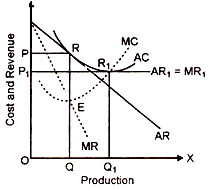Let us make an in-depth study of the determination of price in the long period.
In the long period the price equilibrium under monopolistic competition and Perfect Competition is at that point where MR and MC (i.e., marginal revenue and marginal cost) are equal. And after that the marginal cost starts rising.
Under the Imperfect Competition, the demand curve of the producing firm is a downwards sloping curve. If production is not adjusted according to demand curve but to the production capacity of the plant, the price-level will fall and the firm will incur losses in place of profits. That is why in this type of industry, production is always less than the full production capacity of the plant.
On the other-hand, under perfect competition production is determined at the point, where
ADVERTISEMENTS:
AR = MR = AC = MC
Because the price of every additional unit of production is equal and constant. Therefore, under this type of competition, every firm will put its resources to an optimum use. In this way every production will be larger.
This can be clearer from the following diagram:
Under Imperfect Competition, the equilibrium of the firm is determined at the point E where marginal revenue is equal to marginal cost. Thus, the firm at OP price produces OQ quantity and earns normal profit on the contrary, under perfect competition, the quantity of production is determined at the point R1 because at this point AR = MR = AC = MC.
ADVERTISEMENTS:
Thus, in the long-run under pure competition price will be lower and the production too will be higher than OQ. In short, under Imperfect Competition the price is OP and the quantity of production is OQ whereas under Perfect competition, the price is OP1 and the production level is OQ1.
Therefore, the output is more in perfect competition than imperfect competition, whereas the price is less in perfect competition, whereas the price is less in perfect competition than imperfect competition. But both the firms are earning normal profits in the long-period.
